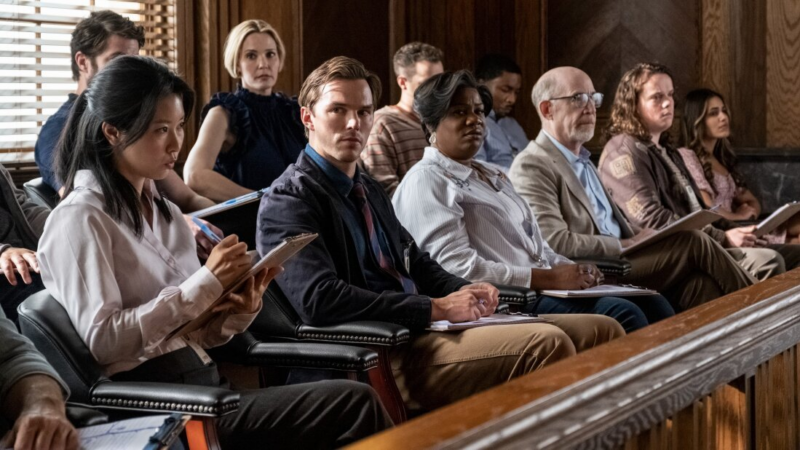SS United States, record-setting ocean liner, makes its final voyage
In the coming days, the United States is expected to take its final voyage, on its way to be buried at sea.
It’s not the country nearing its end, but a ship that bears its name. The SS United States is a mid-20th century ocean liner that set the speed record for crossing the Atlantic. Now tied up at a Philadelphia pier, its paint peeling and faded after decades of inactivity, it’s bound for an ending that is, in reality, a new phase of its life: serving as an artificial reef that attracts divers and marine life in the waters off Florida.
It’s an intricate job to tow a 990-foot ship that no longer has its own working engines. The ship’s planned departure from Philadelphia last week was delayed by the weather, and a new date hasn’t been set. But the United States must go. The pier operator wants its dock space back, and its sale has been completed.
Before departure, a team from NPR climbed aboard what is, in effect, a ghost ship — a relic from the era of great liners that connected North America with Europe. Some of the most famous of these ships are those that sank, like the Andrea Doria, the Lusitania and the Titanic. The builders of the United States learned from others’ mistakes, and it will not go down until it’s scuttled by design.
“If this ship had hit the Titanic’s iceberg, there is no way she would have sunk,” said Susan Gibbs, whose grandfather designed the United States and who has struggled for two decades to preserve it. She told the history of the ship while standing on the foredeck on a sunny afternoon.
“It was a top secret Cold War weapon,” she said. “Its keel was laid right as the Soviet Union tested the atomic bomb.”
The U.S. Navy paid most of the bills because the passenger ship had a military purpose. It could easily be converted to carry thousands of U.S. troops to a war zone, which was a function served by the British liners Queen Mary and Queen Elizabeth during World War II.
Gibbs’ grandfather, William Francis Gibbs, was a Philadelphia native who was fascinated by ships as a child and grew up to design them even though he had no formal training. His achievement during World War II was building so-called Liberty Ships, cargo vessels that carried food and weapons to Europe; they had to be designed and built in such a way that they could be completed by the thousands, more rapidly than German submarines could sink them.
After the war, Gibbs persuaded the government to help him complete his dream: the fastest and safest liner afloat. Its advanced engines and propellers allowed it to sail at 44 land miles per hour — so fast that many warships and submarines of the era would have trouble catching it. (The Queen Mary’s top speed was around 37, and most ships were far slower.)
Watertight compartments made the ship extremely hard to sink; and Gibbs obsessively removed the flammable wood that ordinarily would have formed much of the ship’s interior decor. He insisted on lightweight aluminum — even trying to persuade the piano maker Theodore Steinway to produce an aluminum grand piano.
“Steinway thought that might affect the tonal quality of the instrument, so he refused,” Gibbs said. He finally persuaded the shipbuilder to accept a mahogany piano by dousing the instrument with gasoline and setting it alight; the fuel burned off the hardwood without affecting it.
The ship never served in wartime, instead spending the years from 1952 to 1969 in passenger service for the United States Lines. Musicians including Duke Ellington performed at the mahogany piano in the ballroom. Several presidents were among the passengers; Margaret Truman, a president’s daughter, came along for the record-breaking maiden voyage.
The ship was retired in 1969 as jet travel took over. In more recent years, Susan Gibbs tried to have it repurposed as a floating hotel, which never quite worked.
At last, Okaloosa County, Fla., proposed converting it into the world’s largest artificial reef.
“I’ve shed a few tears.” Susan Gibbs told me. But she added, “this is her next chapter and I am coming to terms with it. And I think it will offer its own sense of dignity and make me even more determined to continue to tell her story.”
I noted that she referred to the ship as “her,” which is the traditional way that ships are discussed. Did the United States have a personality in her mind?
“Yes,” Gibbs said. “I see this ship as a feminist icon. She’s tough. She’s tough and strong and resilient and holds so much.”
Assuming that the ship is successfully towed to Florida’s Gulf Coast, the faded hull will be passed over to engineers, who plan to use explosives to blow holes in the bottom and conduct a controlled sinking in water that is shallow enough for divers to explore it.
Before the sinking, its faded red, white and blue funnels are to be removed and brought to land. They are to be centerpieces of a marine museum, relics of an earlier phase of global travel.










The audio version of this piece was edited by HJ Mai and produced by Kaity Kline and Julie Depenbrock. The digital version was adapted by Majd Al-Waheidi.
Transcript:
STEVE INSKEEP, HOST:
This week, a giant ocean liner will cast off from a Philadelphia pier. The SS United States, which set a speed record crossing the Atlantic in the 1950s, will take its final voyage. So before departure, we climbed aboard.
(SOUNDBITE OF GANG PLANK CLANKING)
INSKEEP: Walking a gang plank through a door in the great black hull, covered in peeling paint.
UNIDENTIFIED GUIDE: So welcome aboard the SS United States.
INSKEEP: Our guide led us up spiral stairs and through cabins stripped back to the walls…
UNIDENTIFIED GUIDE: This would have been first-class cabin space.
INSKEEP: …Until we emerged on deck. I walked all the way to the bow, the very front.
(Shouting) I’m the king of the world.
I repeated that line from the movie “Titanic,” although the United States differs from that famous ship. For one thing, it was better built. The woman who has fought to preserve it says if Leo DiCaprio’s character had traveled on the United States, he would have been fine.
SUSAN GIBBS: If this ship had hit the Titanic’s Iceberg, there is no way she would have sunk.
INSKEEP: Susan Gibbs stood on the foredeck of this ship that was launched in 1951. The U.S. Navy paid most of the bills.
GIBBS: It was a top-secret Cold War weapon. Its keel was laid right as the Soviet Union tested the atomic bomb.
INSKEEP: It was designed to carry thousands of troops in war and passengers in peace from New York to Europe.
GIBBS: So my grandfather, William Francis Gibbs, designed the ship. He was a Philadelphia boy, grew up here.
INSKEEP: And became obsessed with ships at age 8 when he saw one being launched. Though never formally trained as an architect, he went on to design many of the U.S. ships that supplied troops in World War II then built an ocean liner to be fast and fireproof, with almost no wood fixtures. Gibbs insisted on aluminum railings, walls, shelving – everything, almost.
GIBBS: And it even went so far as to a skirmish with – between my grandfather and Theodore Steinway. Steinway was instructed to design a baby grand in aluminum. And Steinway was…
INSKEEP: (Laughter).
GIBBS: …Thought that might affect the tonal quality of the instrument, so he refused. There was a knock-down, drag-out fight. Only when a mahogany piano was doused with gasoline and set on fire, and the flames kind of, you know…
INSKEEP: Burned off.
GIBBS: …Petered out pretty quickly…
INSKEEP: So there was a wood piano in the ballroom where musicians, including Duke Ellington, once played for passengers, including several presidents.
(SOUNDBITE OF ARCHIVED RECORDING)
UNIDENTIFIED REPORTER: The brand-new super liner of the United States races along toward a new trans-Atlantic speed record. She’s averaging better than 40 land miles an hour through some heavy weather.
INSKEEP: The record it set was 3 1/2 days. The ship went out of service in 1969 as jet travel took over. In more recent years, Susan Gibbs tried to have it repurposed as a floating hotel, which never quite worked.
What’s the plan now?
GIBBS: The ship has been purchased by Okaloosa County in Florida. And their plan is to convert her into an artificial – the world’s largest artificial underwater reef.
INSKEEP: The United States, which could never have been sunk by an outside force, will be deliberately scuttled in the Gulf of Mexico. On the promenade deck, we met Jennifer Adams of the Okaloosa County tourist department, who says divers can explore it.
JENNIFER ADAMS: If you’re an expert, you’ll make it to the bottom. I would love to tell that story.
INSKEEP: When you say the bottom, meaning that you would swim inside this ship.
ADAMS: Yeah.
INSKEEP: Somebody might be in scuba gear underwater in this room…
ADAMS: Yes.
INSKEEP: …Where we are or below us somewhere.
ADAMS: Yes.
INSKEEP: And Susan Gibbs, the architect’s granddaughter, is thinking of the fish that will swim through.
Did you have a moment of, like, it was hard to accept this as the solution?
GIBBS: I’ve shed a few tears. Yeah, I’ve shed a few tears. But – how do I say it? This is her next chapter, and I’m coming to terms with it. And I think it will offer its own sense of dignity and makes me even more determined to continue to tell her story.
INSKEEP: You referred to the ship as she, which is the traditional way that ships are referred to. But as I hear you say it, I wonder if this ship almost has a personality, in your mind.
GIBBS: Yes. I see the ship as a feminist icon (laughter). She’s tough. She’s tough and strong and resilient and holds so much. So I do tend to animate her, so to speak.
INSKEEP: This week, the crew plans to cast off the ropes in Philadelphia. The United States is so vast, they will wait for low tide to get the faded red, white and blue funnels under the bridges. In a few weeks, the ship reaches the Gulf Coast, and crews will prepare the United States for its final resting place at the bottom of the sea.
(SOUNDBITE OF SONG, “BEYOND THE SEA”)
BOBBY DARIN: (Singing) Somewhere beyond the sea. Somewhere, waiting for me.
Sudan’s biggest refugee camp was already struck with famine. Now it’s being shelled
The siege, blamed on the Rapid Support Forces, has sparked a new humanitarian catastrophe and marks an alarming turning point in the Darfur region, already overrun by violence.
FDA approves weight loss drug Zepbound to treat obstructive sleep apnea
The FDA said studies have shown that by aiding weight loss, Zepbound improves sleep apnea symptoms in some patients.
Netflix is dreaming of a glitch-free Christmas with 2 major NFL games set
It comes weeks after Netflix's attempt to broadcast live boxing between Jake Paul and Mike Tyson was rife with technical glitches.
Opinion: The Pope wants priests to lighten up
A reflection on the comedy stylings of Pope Francis, who is telling priests to lighten up and not be so dour.
The FDA restricts a psychoactive mushroom used in some edibles
The Food and Drug Administration has told food manufacturers the psychoactive mushroom Amanita muscaria isn't authorized for food, including edibles, because it doesn't meet safety standards.
The jury’s in: You won’t miss anything watching this movie from the couch
There's been a bit of consternation flying around about the fact that the theatrical release of Juror #2, directed by Clint Eastwood, was very muted. But this movie is perfect to watch at home.







